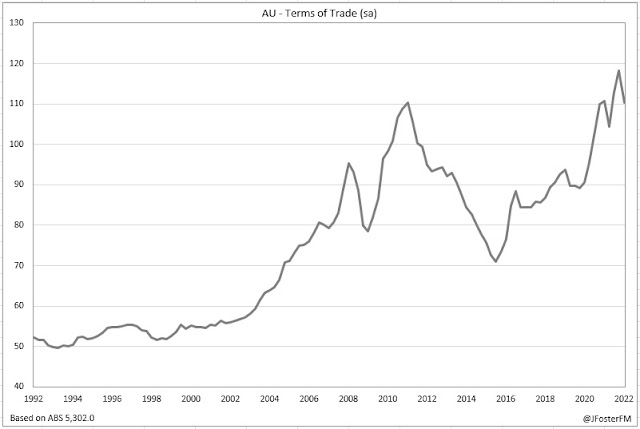Australia recorded a deficit on current account for the first time since early 2019 in the September quarter, ending a historic run of surpluses. A retracement in commodity prices drove a decline in the terms of trade. Net exports will deduct 0.2ppt from economic activity in Q3, but markets had expected a larger fall (-0.5ppt).
- Australia's current account unexpectedly swung into deficit in Q3 at -$2.28bn (vs $6bn expected) from a surplus of $14.75bn in Q2 (revised down from $18.32bn).
- The trade surplus narrowed by $11.1bn to $31.2bn as export earnings weakened (-0.2%q/q) to $172.3bn and import spending accelerated (8.2%q/q) to $141.1bn.
- The income deficit is at record wides, extending out to -$33.2bn from -$26.8bn (revised from -$24bn), driven rising by dividend and interest payments to foreign investors.
- Net exports are expected to deduct 0.2ppt from Q2 GDP growth.
Balance of Payments — Q3 | The details
Australia's international trade dynamics deteriorated in the September quarter as falls in commodity prices weighed on export earnings (-0.2%) and import spending (8.2%) continued to rise, driven by the post-pandemic rebound in services and inflationary effects. The net effect saw the trade surplus narrow by $11.1bn, though it remained historically elevated at around $31.2bn in the quarter.
The 0.2% fall in export earnings came despite the volume of exports rising by 2.7% in the quarter. That was due to export prices falling by 2.8% in the quarter as the prices of key commodity exports retraced from elevated levels. Meanwhile, the 8.2% rise in import spending factors in a 4.1% increase in import prices, with underlying volumes lifting by 3.9%. The key takeaway from all this is that the terms of trade - a tailwind that has supported national income through the Covid period - contracted by 6.7% in Q3, retracing from a record high level. However, that still leaves the terms of trade up by 23% since the end of 2019.
In volume terms, growth in imports (3.9%) outpaced exports (2.7%), which according to the ABS is expected to result in net trade taking 0.2ppt away from GDP in tomorrow's national accounts. In terms of goods trade, the contributions from exports (1.4%) and imports (1.5%) were broadly offsetting. Somewhat surprisingly given an easing in weather-related disruptions, resources exports were soft in Q3 (-0.4%). Goods imports moved to 18.4% above their pre-pandemic level as global supply chain pressures continued to be resolved.
For services, imports (16.2%) well exceeded exports (10.6%). The driving factor is that post the pandemic restrictions on travel, offshore travel by Australians is rebounding at a faster pace than inbound travel by foreign residents, though both are still well down on their respective pre-pandemic levels.
Balance of Payments — Q3 | Insights
The current account surprised by falling into deficit for the first time since Q1 2019. The decline in the terms of trade was expected given the retracement in commodity prices after the surge that followed the Russian invasion of Ukraine. The outcome for net exports was a smaller-than-expected drag for Q3 GDP at -0.2ppt compared to the -0.5ppt deduction expected by markets.
---
The ABS also published quarterly statistics for public demand this morning. Public expenditure was broadly flat rising by just 0.1% in the quarter while underlying investment declined by 0.2%. The ABS's estimates indicate public demand will subtract 0.2ppt from quarterly GDP.







